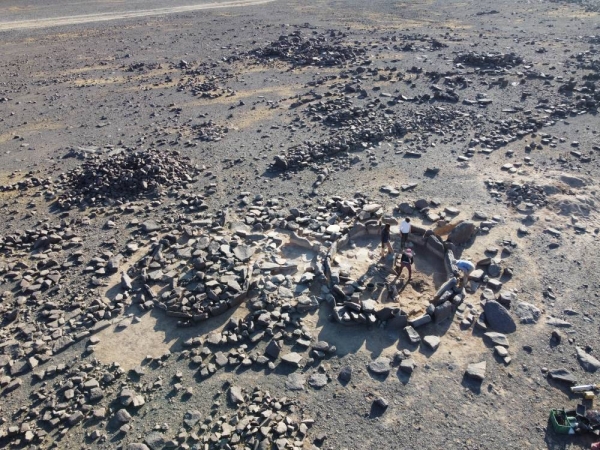An international team sponsored by the Royal Commission for AlUla has uncovered groundbreaking findings on long-term occupation sites in north-west Arabia during the Neolithic period. The team, led by University of Sydney archaeologist Jane McMahon, recently published their research in the Levant journal, shedding new light on the settled lifestyle in the region during the 6th and 5th millennia BCE. The team analyzed unique dwellings known as Standing Stone Circles, which are double rows of upright stone slabs forming circles 4 to 8 meters in diameter, possibly supporting roofs made of animal skins.
In their study, the team examined 431 such circles in AlUla County’s Harrat Uwayrid, with 11 being excavated in-depth and 52 surveyed. Jane McMahon emphasized that the findings challenge assumptions about early north-west Arabian life, revealing not just pastoralists but also distinct architecture, domestic animals, and a variety of artifacts. The scale of these circles suggests a larger population than previously believed, providing insights into the region’s Neolithic past.
Rebecca Foote of the Royal Commission for AlUla highlighted the importance of sponsoring such research to deepen understanding of the region’s Neolithic past. The findings from this study demonstrate how these ancient communities lived and interacted, offering a glimpse into their daily lives and cultural exchanges. The research also revealed diverse animal remains indicating a mixed economy, arrowheads linking to Jordan, and shells suggesting coastal connections, marking a significant leap in understanding early civilizations in the region.
The discoveries made by the international team shed new light on the long-term occupation sites in north-west Arabia during the Neolithic period. The analysis of Standing Stone Circles in AlUla County’s Harrat Uwayrid provides insights into the settled lifestyle of the region’s inhabitants during the 6th and 5th millennia BCE. By examining 431 such circles and conducting in-depth excavations on 11 of them, the team discovered a surprising array of artifacts and evidence of a larger population than previously thought.
Jane McMahon, the lead archaeologist of the University of Sydney, noted that the study challenges existing assumptions about early north-west Arabian life. The presence of distinct architecture, domestic animals, and diverse artifacts in these circles suggests a more complex society than just pastoralists. Rebecca Foote of the Royal Commission for AlUla emphasized the importance of sponsoring research to deepen our understanding of the region’s Neolithic past, highlighting the significance of this study in revealing how these ancient communities lived and interacted.
The study’s findings include a diverse range of animal remains indicating a mixed economy, arrowheads that can be linked to Jordan, and shells suggesting connections to coastal regions. This research marks a significant advancement in understanding the early civilizations that once thrived in the region. By uncovering these new insights into the settled lifestyle and cultural exchanges of the Neolithic communities in north-west Arabia, the international team has contributed to expanding our knowledge of the region’s ancient history.
In conclusion, the research sponsored by the Royal Commission for AlUla has provided groundbreaking insights into the long-term occupation sites in north-west Arabia during the Neolithic period. The analysis of Standing Stone Circles in AlUla County’s Harrat Uwayrid has revealed a complex society with distinct architecture, domestic animals, and a variety of artifacts, challenging previous assumptions about early north-west Arabian life. These findings offer a glimpse into the daily lives and cultural exchanges of the region’s ancient communities, marking a significant advancement in our understanding of early civilizations in north-west Arabia.





















